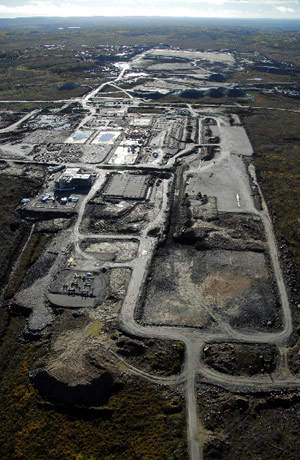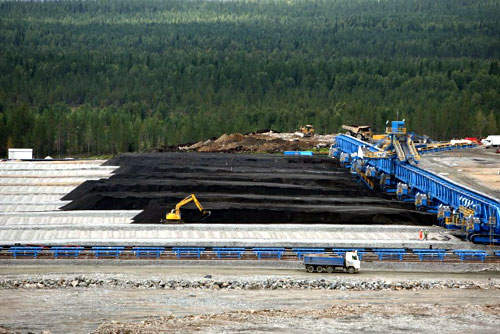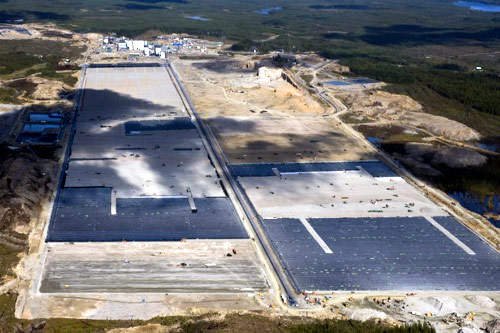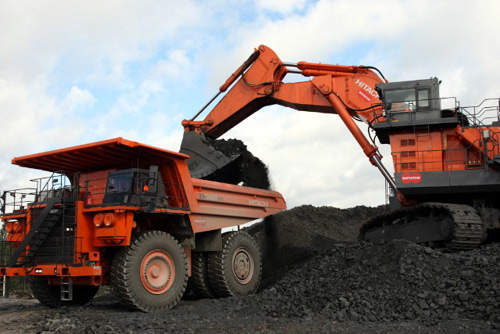Talvivaara’s bioheapleach project – the world’s first for nickel – is centred on two polymetallic deposits, Kuusilampi and Kolmisoppi, about 30km southwest Sotkamo, eastern Finland. They form one of the largest known sulphide nickel resources in Europe and, as well as nickel, the open-pit mine is also expected to produce copper, zinc and cobalt as by-products of the process. First metal was produced on schedule at the beginning of October 2008.
The mining licenses for this area were originally granted to Finland-based stainless steel company Outokumpu in 1986, and the exploration rights were subsequently transferred to Talvivaara in February 2004. In May 2007, Outokumpu exercised its option to acquire a 20% interest in Talvivaara.
The £355m project has been financed through a share offering in 2007 that raised about £230m; the rest has been raised through a term loan.
Geology
The Talvivaara orebodies sit within the Kainuu Schist Zone, a north-south trending schist belt that extends from Rautavaara in the south via Sotkamo, Ristijärvi, Paltamo and Puolanka through to Pudasjärvi in the north. The zone consists of a series of metasediments of greenschist to upper amphibolite facies belonging to the Karelia supergroup, which rest unconformably on the Archaean basement gneiss complex.
The host rocks of the Talvivaara deposit consist of variably re-crystallised carbon and sulphide-rich black metasediments (black schists) bounded by medium-grained mica schist and Jatulian quartzites. These black schist formations range in thickness from tens of metres to 100m, except in the immediate project area where the unit has been tectonically thickened.
The main mineral assemblage in the black schists is quartz, biotite, graphite and sulphides with accessory minerals of rutile, chlorite, oligoclase, microcline, apatite, garnet, tourmaline and epidote.
Resources
The project has total measured, indicated and inferred resources of 414Mt (0.15% Ni cut-off) containing 0.26% Ni, 0.02% Co, 0.14% Cu and 0.54% Zn. Total proved and probable reserves are about 257Mt, at about the same grades.
Production
The resources are sufficient to keep the mine in production for at least 24 years, with an expected annual nickel output of about 33,000t and the potential to provide nearly 2.5% of the world’s current nickel production by 2010. The Kuusilampi pit will be mined first with the Kolmisoppi pit coming on line in 2019.
As well as nickel, the mine is also expected to produce about 60,000t/year of zinc, 10,000t/year of copper and 1,200t/year of cobalt.
Processing
The process flow at Talvivaara consists of three main steps – crushing, bioheapleaching and metals recovery.
Crushing will be carried out in three stages, followed by agglomeration with sulphuric acid to consolidate the fines with coarser ore particles.
Bioheapleaching
Bioleaching is a process whereby metals are leached from ore as a result of bacterial action. In nature, bioleaching is triggered spontaneously by micro-organisms in the presence of air and water. Commercially applied bioleaching technologies use the same phenomenon, but accelerate this natural process. The bacteria used in the Talvivaara process grow naturally in the ore, and the company reports recovery rates of up to 98% of metal from ore to solution.
The heap leaching will be operated in two stages, a primary heap pad residence time of 1.5 years and a secondary pad residence time of 3.5 years.
Process plant
The process plant design includes two parallel circuits each rated at 600m3/h of pregnant leach solution (PLS). Each circuit consists of copper recovery, zinc recovery, neutralisation and aluminium removal, nickel and cobalt recovery, iron removal and then final precipitation.
The copper and zinc recovery units precipitate the metals from their sulphides in the PLS using hydrogen sulphide. The precipitates are then recovered in thickeners and filtered to produce saleable products.
The recovery of nickel and cobalt first requires the pH of the solution to be raised to 3.7-4.0, which precipitates most of the aluminium from the solution and also produces a large quantity of gypsum. This precipitate is separated in thickeners and the underflow filtered and stored in the waste rock area.
The nickel and cobalt are then recovered by precipitation using hydrogen sulphide, while maintaining the pH at 3.6-3.8. The two metals precipitate at the same time, so there is one mixed product. The precipitate is recovered in thickeners and then filtered to produce a saleable product.
The residual solution is then neutralised and the residual metals removed from the solution. The bulk of the iron remaining in solution is removed by aerating the solution to oxidise the iron which precipitates as goethite or as a hydroxide. The slurry is thickened and the thickener underflow is sent to the gypsum pond for storage. The bulk of the remaining solution is sent to the PLS pond.
For final precipitation the pH is raised to pH 9-10 using burned lime slurry. The residual metals are precipitated as hydroxides, and gypsum is also formed. The slurry is thickened and the thickener underflow disposed of in the gypsum ponds. The solution is sent to the PLS pond.
Talvivaara has a 10-year offtake deal to sell all its output of nickel and cobalt at market prices to the Norilsk Harjavalta refinery.
Logistics
The existing main access to the project area is a regional highway. The site is well connected to the highway network via the local roads in all directions and is close to the main railway network.
The main power source for the project is electricity, with a demand of about 45MW, supplied from the Finnish grid via a new overland powerline from the Fingrid substation at Vuolijoki, about 43km west of the project area.
The main water supply is from Lake Kolmissoppi but in low flow times it will not be able to support the permitted 4,000m3/h demand, so 20% of the supply would be taken from Lake Nuasjärvi. The project also has emergency storage ponds, which will be run at 50% of capacity to accommodate storm water. During the first couple of years of operation there will be no secondary leaching; this will later take various water streams from the primary leach pond, the pit and waste dump drainage.
Drinking water will be supplied from a handful of boreholes.






